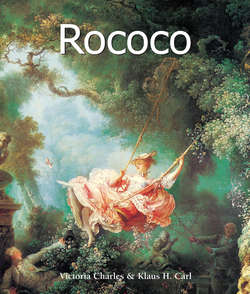Читать книгу Rococo - Victoria Charles - Страница 12
На сайте Литреса книга снята с продажи.
I. Rococo in France
Antoine Watteau and His Successors
ОглавлениеAntoine Watteau (1684–1721) was one of the key figures in Rococo art. Of Flemish origin, he came to Paris around 1702, where his interest in genre painting and in the world of theatre (especially the commedia dell’arte) was aroused. Through the influence of Rubens (1577–1640), his style did not change so much as his subject matter – the “gay, wanton party”. After the pomp of Louis XIV, artists now concentrated on the pleasant, the private and the delicate. In the political sphere and aesthetic movements, there was a noticeable relaxation – art reacted to it with intimate, decorative and erotic motifs and mythological scenes. The pleasures of the flesh celebrated in his pastoral pieces were perhaps really a glorification of true love – at any rate, they portrayed the most hedonistic joys of life. Watteau possessed the rare gift of atmospheric colouration, which even in the brightest light still conveyed gentleness, mystery and a kind of musicality, combined with great artistic skill which put him on a par with the masters.
Watteau was the most brilliantly sophisticated painter of the 18th century who, despite his short life, dogged by problems of constant ill health, nevertheless created a series of masterpieces which have never lost their effectiveness that transcended the taste of the age. In his homeland he had made friends with Rubens and a series of other Dutchmen, whose style he adapted. In Paris, he found several friends and influential patrons who made it possible for him to freely exercise his art. At first he was a pupil and assistant of the painter, drawer and etcher Claude Gillot (1673–1722), who in particular acquainted him with the theatre, in which at the time there was a battle for supremacy on the stage between the French and Italian comedies. Watteau derived the Rococo style from the decorative style of the age of Louis XIV, in association with Chinese and Japanese forms of ornamentation characterised by the decorative painting in rooms, boudoirs and salons. From the pastoral plays in the theatre he borrowed the coquettish costumes in which he clad the ladies and gentlemen in his pictures, and depicted them on leisurely outings in the parks of the palaces of nobles and princes, or in rural scenes isolated from the stresses and strains of everyday business and life. He often painted his subjects engaged in relaxation or tender flirtation.
François Boucher, The Triumph of Venus, 1740.
Oil on canvas, 130 × 162 cm.
Nationalmuseum, Stockholm.
Jean-Baptiste Pater, Scene in a Park, c. 1720–1730.
Oil on canvas, 149 × 84 cm.
The State Hermitage Museum, St. Petersburg.
Jean-Honoré Fragonard, Love’s Sermon.
Oil on canvas, 62.2 × 51.3 cm.
Villa-Musée Jean-Honoré-Fragonard, Grasse.
Jean-Honoré Fragonard, Sacrifice of the Rose, 1780–1785.
Oil on wood, 54 × 43 cm.
Parfumerie Fragonard Collection, Grasse.
François Boucher, The Toilette, 1742.
Oil on canvas, 52.5 × 66.5 cm.
Museo Thyssen-Bornemisza, Madrid.
Jean-Siméon Chardin, Morning Toilette, 1741.
Oil on canvas, 49 × 39 cm.
Nationalmuseum, Stockholm.
The constantly over-stimulated people of that time interpreted these pictures as a paradise in which their imaginations could run wild. Even earnest men whose thoughts were directed towards lofty goals sought consolation and convalescence from serious intellectual battles. One of the great admirers of Watteau was King Frederick II of Prussia (1712–1786), who adorned his palace with Watteau’s pictures.
Amongst Watteau’s best works are, of course, La Leçon d’amour (the Lesson in Love) (c. 1716), The Pilgrimage to the Island of Cythera and The Dance (between 1710 and 1720). The Gersaint’s Shop Sign (1720), a sign painted for the Paris art dealer Gersaint, depicted the interior of the sale room and the distinguished visitors, thus capturing the reality of the time. One of his most beautiful pictures, The Surprise (c. 1718), had been missing since the mid-19th century and presumed to be destroyed until 2008, when it was discovered in an English country house and soon afterwards sold at auction for more than €15 million. What Watteau had depicted in his pastoral scenes and lively entertainments nevertheless influenced reality insofar as certain items of clothing such as bonnets, bodices, skirts and other ensembles of feminine dress were taken over from the fashion of that time and were still worn 150 years after Watteau’s death.
Amongst Watteau’s numerous imitators, only two have really made a name for themselves. One is Watteau’s student and friend Nicolas Lancret (1690–1743), who in his pictures, widely distributed particularly through engravings, continued the tradition of pastoral scenes and joyous parties. Amongst his best-known pictures are Game in the Open Air and Moulinet, (both early 18th century) or even the Breakfast with Ham (1735). The other is Jean-Baptiste Pater (1695–1736), who initially was trained by his father as a sculptor and later, like a good pupil, obediently stuck to the tracks laid down by Watteau, but brought with him some Flemish humour. He made the artistic form hitherto featured only in life at court and amongst the aristocracy rather more folksy. Pater depicted, in exactly the same way as François Boucher (1703–1770) and Lancret, al fresco parties and dances in marvellous colours. Pater’s masterpieces include The Fortune Teller, The Bathers (c. 1730) and The Joys of Country Life (1730–1735).
